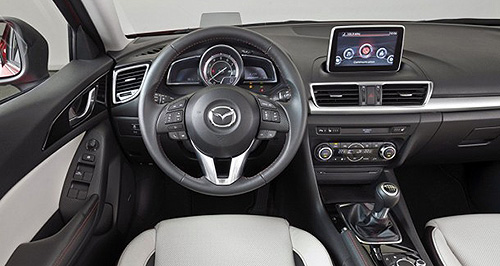Future models - Mazda - Mazda3Mazda3 no longer driven to distractionChange-up: The new Mazda3 cabin is cleaner, simpler and less distracting. Cabin revamps in new Mazda3 designed to keep eyes fixed on the road17 Jul 2013 By BYRON MATHIOUDAKIS in LOS ANGELES MAZDA wanted to eliminate dangerous in-car driving distractions while improving functionality on multiple front when designing the interior of the new ‘3’. As such, the car will read your text messages, project driving data onto the windscreen and eschew a touchscreen in favour of an easier-to-reach rotary dial, among other things. Expected to be the only sub-$40,000 small-car at its launch early next year to offer a HUD heads-up display unit, the 2014 BM-series sedan and hatch introduces Mazda’s new human/machine interface layout for the first time. It includes a fresh multimedia system in ‘floating’ dash-top tablet form that has been ‘future-proofed’ where possible against rapid obsolescence thanks to modular hardware and updatable software. Clearer graphics, improved vision, better-padded seat cushions, tailored noise-eradicating measures and a more ergonomic and intuitive rotary controller also make their debut. Dubbed Mazda’s ‘Heads-Up Cockpit’, and three years in the making, the goals are to cut driver distraction on a visual, cognitive, and ‘manual’ level, necessitating a clear demarcation between vehicle operation and in-car entertainment ‘zones’. “The amount of information shown to the driver is increasing, and so is the danger of driver distraction,” says Ryuichi Umeshita, Mazda Motor Corporation product planner. “We believe in people as human beings not computers. It is based on human engineering. It is one of the fundamental basics of Mazda.” The high degree of packaging improvement and refinement was possible because of the Mazda3’s wholesale new-from-the-ground-up redesign, as part of the SkyActiv chassis and drivetrain implementation. Directly ahead of the driver is an instrument binnacle sited within his/her vision with information that now requires less time-wasting and fatigue-inducing eye and head movement to absorb. It only shows necessary driving information, including speed, engine revs, and safety-related alerts, in clear white-on-black background. Where colour is used in the digital displays it is to maximise clarity. Choose a Mazda3 with optional HUD and a small plastic screen raises to reflect the info above as well as automatic cruise control speed settings, turn-by-turn directions from the sat-nav system if fitted, and alerts from the new safety systems like the ‘Smart City Brake Support’ (low-speed emergency auto braking) and Lane Departure Warning. Research shows that older drivers will especially benefit from using a HUD system. Meanwhile, in the centre is a tablet screen – in two sizes according to specification – with the bigger one adding sat-nav and detailed audio info to the more basic version’s general audio and vehicle functionality menus. Mazda says the tablet is mounted on the dash to minimise downward movement of the eyes to an acceptable 13 degrees. All text sizes are significantly larger than before, with more space between them, in a field showing seven lines of information maximum, so as to be quickly read for faster comprehension. While the centre display is touchscreen, the rotary controller located near the repositioned conventional handbrake lever (an electric item will be ready at facelift or next-generation time) is designed to be intuitive and concise, with its actions mirrored on the screen. Mazda says it is preferable to using a touchscreen because the time and effort it takes to position a finger on a particular part of a display when the car is in motion is especially distracting. To that end, there’s voice activation for many functions, and a separate on/off volume dial, while five buttons for each hand’s digit further simplifies the menu selection process. The latter offers BMW i-Drive-style short cuts to the main functionalities as well as the driver’s favourites – be it audio, navigation, vehicular control, or multi-media. Speaking of which, in-vehicle connectivity is available via Bluetooth to access audio, phone (including email and SMS display/text-to-voice readout), and Internet services, while updates are possible at the OS operating system level, enabling access to latest changes without the need to swap hardware. In some markets the regular in-car terrestrial radio system is augmented by digital broadcasts via a smartphone, though if that also applies to Australian-bound Mazda3s at launch is unknown. Finally, Mazda says slimmer pillars and relocated door mirrors help improve forward visibility, deeper seat cushions designed to aid comfort and cut fatigue are fitted following widespread criticism of those found in the CX-5, while no major vehicle operating switch or control is a stretch away.  Read more15th of July 2013  MX-5 sets Mazda3 behaviourMazda benchmarks MX-5 roadster to sharpen up '3' small-car's dynamics15th of July 2013  Mazda puts big tickets on all-new small sedanAll-new Mazda3 sedan could match the popular hatch in sales terms Down Under15th of July 2013  Mazda’s SkyActiv revolution to continue apaceRange-wide revamp will see five new-generation Mazdas by 2016Mazda3 pricing
Motor industry news |
Click to shareMazda modelsResearch Mazda Mazda3 pricing
Motor industry news |


















































Facebook Twitter Instagram